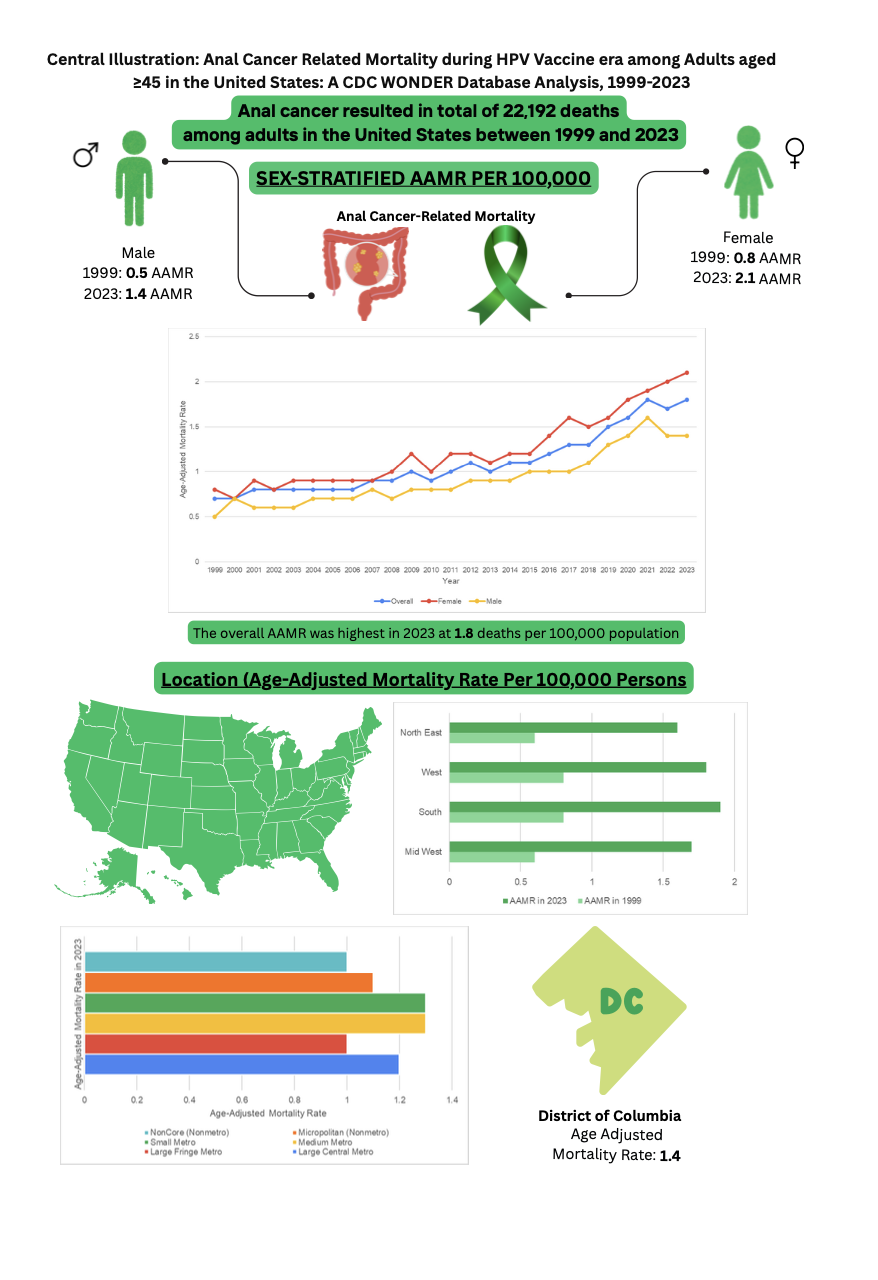Sunday Poster Session
Category: Colon
P0254 - The Missed Screening Crisis: Rising Anal Cancer Related Mortality During HPV Vaccine Era Among Adults Aged ≥45 in the United States

Avinash Nankani, MBBS (he/him/his)
Dow University of Health Sciences
Karachi, Sindh, Pakistan
Presenting Author(s)
1North Central Bronx Hospital, Bronx, NY; 2Dow University of Health Sciences, Karachi, Sindh, Pakistan; 3Dow Medical College, Karachi, Sindh, Pakistan; 4Wright Center for Graduate Medical Education, Scranton, PA; 5Florida State University, Cape Coral, FL; 6Luminis Health Anne Arundel Medical Center, Annapolis, MD; 7Creighton University School of Medicine, Phoenix, AZ; 8NYC Health + Hospitals/Jacobi, Bronx, NY
Introduction: Human papillomavirus (HPV) is the most common sexually transmitted infection with nearly 80 million Americans living with some kind of HPV. High-risk types 16 and 18 have been associated with anal squamous cell carcinoma, which has exhibited increasing incidence and mortality rates in the United States (U.S.) over the recent decades. While the introduction of the HPV vaccine aimed to reduce HPV-associated cancers, its impact on older adults, particularly those aged ≥45, remains unclear. We conducted this study to assess trends in anal cancer-related mortality among U.S. adults aged ≥45 during the HPV vaccine era.
Methods:
A retrospective analysis was conducted using data from the Centers for Disease Control and Prevention Wide-Ranging Online Data for Epidemiologic Research (CDC WONDER) database. Anal cancer deaths were identified using ICD-10 code C21, and age-adjusted mortality rates (AAMRs) per 100,000 population were calculated for adult men aged ≥45, standardized to the 2000 U.S. Census population. Mortality trends were examined by year, sex, urbanization, state, and U.S. Census region. Descriptive statistics and linear trend analysis were used to assess changes over time.
Results:
Between 1999 and 2023, a total of 22,192 deaths occurred from anal cancer. The AAMR increased from 0.7 in 1999 to 1.8 in 2023 per 100,000 population. Females had consistently higher AAMRs throughout the study duration compared to males (overall AAMR females 2 vs males 1.5). AAMR also varied by region (overall AAMR: West:1.2; South: 1.1; Midwest: 1; Northeast: 0.9), and small metropolitan areas had relatively higher overall AAMR (0.8) than medium metropolitan and micropolitan/noncore nonmetropolitan (0.77) and large central (0.76) and fringe metropolitan areas (0.7) between 1999 and 2020. States in the top 90th percentile exhibited nearly twice the AAMRs compared to states that fell into the bottom 10th percentile.
Discussion:
The mortality rate associated with anal cancer in the U.S. has shown an alarming rise over the past two decades. Significant demographic and geographic discrepancies are highlighted by the persistently higher mortality rates seen in females, regional disparities, and elevated rates in small metropolitan regions, highlighting the need for enhanced screening, aggressive management, and consistent surveillance for anal cancer in HPV patients at risk.

Figure: Central illustration summarizing trends in anal cancer–related mortality among U.S. adults aged ≥45 during the HPV vaccine era (1999–2023), based on CDC WONDER data. A total of 22,192 anal cancer–related deaths were recorded.
Top panel: Sex-stratified age-adjusted mortality rates (AAMRs) increased for both males (from 0.5 in 1999 to 1.4 in 2023) and females (from 0.8 to 2.1).
Middle panel: Overall AAMR peaked in 2023 at 1.8 deaths per 100,000. Regional analysis revealed the highest AAMRs in the South and Northeast.
Bottom panel: Urban-rural classification shows the highest mortality in Large Central Metro areas and lowest in Small Metro regions. District of Columbia had an AAMR of 1.4 in 2023.
Disclosures:
Rahul Kumar indicated no relevant financial relationships.
Avinash Nankani indicated no relevant financial relationships.
Tahreem Mari indicated no relevant financial relationships.
Saifullah Khan indicated no relevant financial relationships.
Sunny Kumar indicated no relevant financial relationships.
Diksha Kajal indicated no relevant financial relationships.
Akshay Sharma indicated no relevant financial relationships.
Vikash Kumar indicated no relevant financial relationships.
Sunny Patel indicated no relevant financial relationships.
Rahul Kumar, MD1, Avinash Nankani, MBBS2, Tahreem Mari, MBBS3, Saifullah Khan, 3, Sunny Kumar, MD4, Diksha Kajal, MD5, Akshay Sharma, MBBS6, Vikash Kumar, MD7, Sunny Patel, MD8. P0254 - The Missed Screening Crisis: Rising Anal Cancer Related Mortality During HPV Vaccine Era Among Adults Aged ≥45 in the United States, ACG 2025 Annual Scientific Meeting Abstracts. Phoenix, AZ: American College of Gastroenterology.
